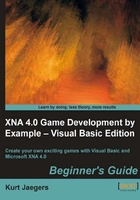
Time for action – generating falling pieces
- Modify the
FillFromAbove()method of theGameBoardclass by adding a call to generate falling pieces right before therowLookup = -1line (inside theIfblock):AddFallingPiece(x, y, GetSquare(x, y), GamePiece.PieceHeight * (y - rowLookup)) - Update the
GenerateNewPieces()method by adding the following call, right after theRandomPiece(x,y)line as follows:AddFallingPiece(x, y, GetSquare(x, y), GamePiece.PieceHeight * (GameBoardHeight + 1))
What just happened?
When FillFromAbove() moves a piece downward, we now create an entry in the FallingPieces dictionary that is equivalent to the newly moved piece. The vertical offset is set to the height of a piece (40 pixels) times the number of board squares the piece was moved. For example, if the empty space was at location 5, 5 on the board, and the piece above it (5, 4) is being moved down one block, the animated piece is created at 5, 5 with an offset of 40 pixels (5-4 = 1, times 40).
When new pieces are generated for the board, they are added with an offset equal to the height (in pixels) of the game board (recall that we specified the height as one less than the real height, to account for the allocation of the extra element in the boardSquares array), determined by multiplying the GamePiece.PieceHeight value by GameBoardHeight +1. This means they will always start above the playing area and fall into it.